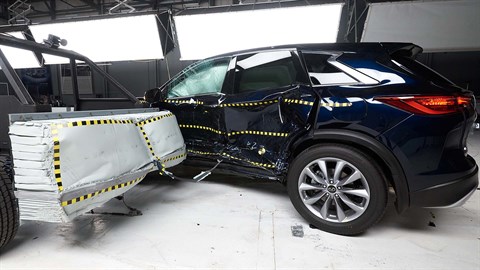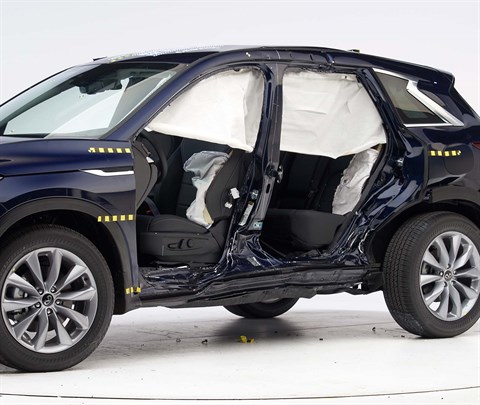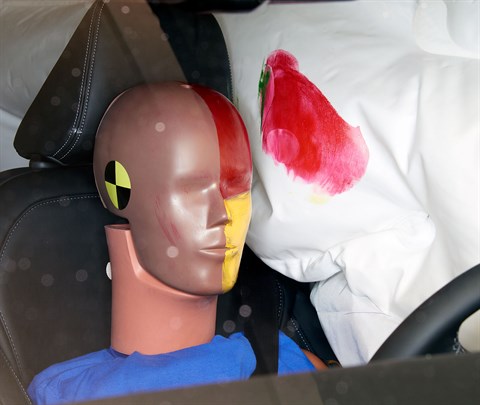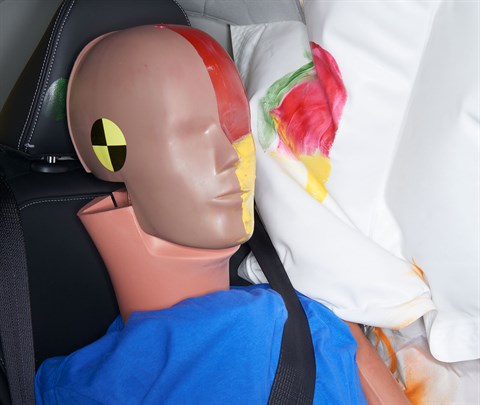Moderate overlap front: original test
Rating applies to 2021-25 models
Tested vehicle: 2021 Infiniti QX50 Essential 4-door 4wd
The Infiniti QX50 was redesigned for the 2019 model year after a one-year absence from the market. Beginning with 2021 models, design changes were made to the front driver and passenger seat belts and passenger-side frontal and knee airbags to improve occupant protection in frontal crashes.
Moderate overlap frontal ratings are assigned by the Institute based on a test of a 2021 QX50 conducted by Nissan. Because the structure was not changed, the structure rating is based on this verification test and an earlier test of a 2019 QX50 conducted by Nissan.
These ratings also apply to the structurally similar Infiniti QX55, introduced in the 2022 model year.
| Evaluation criteria | Rating |
|---|---|
| Overall evaluation | |
| Structure and safety cage | |
| Driver injury measures | |
| Head/neck | |
| Chest | |
| Leg/foot, left | |
| Leg/foot, right | |
| Driver restraints and dummy kinematics | |
Side: original test
Rating applies to 2021-25 models
Tested vehicle: 2021 Infiniti QX50 Essential 4-door 4wd
The Infiniti QX50 was redesigned for the 2019 model year after a one-year absence from the market. Beginning with 2021 models, rear side airbags were added, and design changes were implemented to the side structure, including the B-pillar, to improve occupant protection in side impact crashes.
Side ratings are assigned by the Institute based on a test of a 2021 QX50 conducted by Nissan.
| Evaluation criteria | Rating |
|---|---|
| Overall evaluation | |
| Structure and safety cage | |
| Driver injury measures | |
| Head/neck | |
| Torso | |
| Pelvis/leg | |
| Driver head protection | |
| Rear passenger injury measures | |
| Head/neck | |
| Torso | |
| Pelvis/leg | |
| Rear passenger head protection | |
Side: updated test
Rating applies to 2021-25 models
Tested vehicle: 2022 Infiniti QX50 Pure 4-door 4wd
The Infiniti QX50 was redesigned for the 2019 model year after a one-year absence from the market. Beginning with 2021 models, rear side airbags were added, and design changes were implemented to the side structure, including the B-pillar, to improve occupant protection in side impact crashes.
Two side 2.0 tests of the QX50 were conducted, one by the Institute and the other by Nissan. Ratings are based on both tests, but the vehicle specifications shown below are based on the Institute’s test.
| Evaluation criteria | Rating |
|---|---|
| Overall evaluation | |
| Structure and safety cage | |
| Driver injury measures | |
| Head/neck | |
| Torso | |
| Pelvis | |
| Driver head protection | |
| Rear passenger injury measures | |
| Head/neck | |
| Torso | |
| Pelvis | |
| Rear passenger head protection | |

View of the vehicle just after the crash test.

View of the vehicle after the crash with doors removed, showing the side airbags and damage to the occupant compartment.

Smeared greasepaint shows where the driver dummy's head was protected from being hit by hard structures by the side airbags.

Smeared greasepaint shows where the rear passenger dummy’s head was protected by the side airbags.
Front crash prevention: vehicle-to-vehicle
Seat belt reminders
Rating applies to 2022 models
| Evaluation criteria | Rating |
|---|---|
| Overall evaluation | |
| Front row | |
| Unbelted occupant alert (audible & visual) | |
| Initiation time | |
| Duration | Long enough (90+ seconds) |
| Volume | |
| Audio frequency | |
| Second row | |
| Startup status alert (visual) | |
| Initiation time | |
| Duration at least 60 seconds | |
| Belt disengaged alert (audible & visual) | |
| Initiation time | |
| Duration at least 30 seconds | |
| Volume | |
| Audio frequency | |
